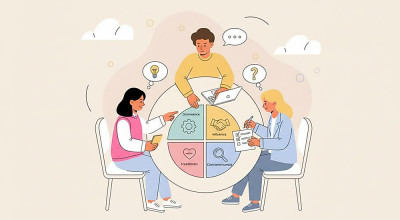Communication Styles Assessment: Take DISC Self-Assessment
New Updates



Take Communication Styles Assessment Online
Get StartedUnlock Better Conversations With Our Communication Style Assessment
Human behavior in the workplace unfolds through patterns that repeat under pressure and calm, revealing how we drive results, relate to others, and process information. The DISC model translates these patterns into four primary tendencies Dominance, Influence, Steadiness, and Conscientiousness so teams can align expectations and reduce friction. Rather than forcing labels, the framework maps observable behaviors that anyone can recognize without guesswork.
Beyond typology, the model helps practitioners track how situational context shapes reactions, motivations, and blind spots. In practical terms, the DISC assessment meaning points to a behavioral lens that clarifies needs, fears, and default strategies during collaboration. You can use it to decode how people prefer decisions to be made, how they like information presented, and where they might need support during change. Results typically arrive as a narrative profile, graphs, and tips that compare natural tendencies with adapted workplace behavior. For implementation, the DISC assessment functions like a shared language that accelerates rapport building and shortens the learning curve for new teams. Coaches, facilitators, and managers can anchor conversations in neutral, descriptive language that honors differences while nudging growth.

Benefits for Communication, Culture, and Collaboration
Organizations thrive when messages land, expectations are clear, and feedback is timely. The DISC framework turns ambiguous interactions into a set of practical choices: how much detail to include, how quickly to decide, and what tone best invites cooperation. When people understand their tendencies and those of colleagues, meetings become more focused, handoffs smoother, and conflict less personal.
For diagnosing gaps in how messages travel across departments, a structured communication assessment provides a baseline for improvement plans. Leaders can then tailor channels, cadences, and templates that suit varied preferences without diluting accountability. Over time, the result is a culture where clarity feels normal and rework diminishes. Managers who coach intentionally often pair skill-building with a targeted communication style assessment to reveal preference patterns that derail presentations or one-on-ones. With small shifts like opening with big-picture outcomes for fast movers or providing stepwise context for deliberative thinkers teams experience fewer misunderstandings.
- Meeting design benefits from agendas that flex for pace and detail without sacrificing outcomes.
- Feedback lands better when phrased to match motivation, such as progress, harmony, accuracy, or recognition.
- Project kickoff improves when roles are aligned to strengths and risk points are named in plain language.
When change arrives, readiness plans that reference a broader communication styles assessment help reduce resistance, because messaging considers different processing speeds and concerns from the outset. That reduces costly delays and protects trust during transitions.
Communication Styles Assessment: Interpreting Profiles and the Classic Wheel
Reading a behavioral profile starts with understanding which tendencies are primary, which are secondary, and how they interact. A DISC profile assessment provides this overview in a concise, practical format. The interaction matters, because combinations alter how strengths show up; for example, drive paired with empathy looks different than drive paired with analysis. Practitioners coach people to adjust based on audience, goal, and timeline, not to chase a perfect style.
For a visual map of intensity and blends, many practitioners rely on the DISC assessment wheel to locate where someone’s pattern sits relative to others. This map helps teams see coverage, gaps, and potential friction points long before they become performance issues. It also anchors development goals in concrete, observable behaviors rather than abstract traits. Detailed narratives add nuance by explaining triggers, stress behaviors, and collaboration tips. When patterns collide, reframing differences as complementary reduces defensiveness and fuels problem-solving. The snapshot below highlights common strengths, stress responses, and preferred environments across the four classic tendencies.
| Style | Typical Strengths | Stress Behavior | Preferred Environment |
|---|---|---|---|
| Dominance (D) | Decisive, driven, results-focused | Impatience, overcontrol, bluntness | Fast pace, autonomy, clear goals |
| Influence (I) | Persuasive, optimistic, energizing | Overpromising, distraction, talk over detail | Interactive forums, recognition, brainstorming |
| Steadiness (S) | Supportive, patient, collaborative | Resistance to change, conflict avoidance | Stable routines, teamwork, clear expectations |
| Conscientiousness (C) | Accurate, analytical, quality-oriented | Overanalysis, risk aversion, rigid standards | Structured processes, data, defined rules |
Interpreters should emphasize adaptability, reminding users that every style can flex with intention and practice. Success hinges on turning self-insight into micro-behavioral shifts that respect both task demands and relationship health.
Leadership, Management, and Coaching Applications
Leaders juggle competing priorities: setting direction, aligning stakeholders, and developing people. The DISC framework shortens the path from awareness to action by supplying targeted strategies for delegation, decision-making, and conflict mediation. When managers shift their approach to match the context and the person, they spend less time firefighting and more time compounding momentum.
For executive development, a focused DISC leadership assessment can illuminate which tendencies drive strategic impact and which create ripple effects under stress. That clarity helps senior teams calibrate communication norms, meeting rhythms, and escalation paths that sustain execution across functions. Operational teams benefit when role design and process tweaks reflect everyday reality. Within hiring, the DISC workplace assessment supports structured interviews and onboarding plans that set expectations early. Coaches can then use situational exercises to reinforce strengths while building range where the job demands it most.
- Delegation improves when leaders assign tasks based on energy sources, not just capability.
- Performance reviews become future-focused when feedback ties behaviors to outcomes and stakeholder needs.
- Change initiatives land faster when messaging anticipates reactions and offers practical adaptations.
How to Administer and Interpret Your Communication Style Assessment Results
Rolling out a behavioral instrument goes smoothly when logistics, privacy, and context are handled up front. Set clear expectations about time required, data usage, and how insights will influence collaboration. Provide a debrief that translates graphs into actionable takeaways, and follow up with practice prompts that embed new habits.
For reliability, many organizations standardize on a validated DISC assessment test as part of their talent toolkit. The debrief should include scenario-based coaching that converts insights into small, trackable shifts employees can make in real meetings.

Scheduling matters, because participants need mental space to reflect without pressure. To build momentum, encourage new hires and cross-functional partners to take DISC assessment during onboarding or project kickoff, then revisit the conversation after a few weeks. Reinforcement can come through peer coaching circles, job aids, and manager-led check-ins.
- Provide guides that translate style blends into meeting, email, and feedback tips.
- Normalize adaptation by celebrating examples where someone flexed effectively.
- Protect psychological safety by keeping results descriptive, not evaluative.
Access Options, Pricing, and Ethical Use
Selection of a provider should weigh psychometric rigor, reporting clarity, and support for facilitators. Some teams prefer enterprise platforms with analytics and integrations, while others choose simpler tools for quick rollouts. Whatever the choice, consistent administration and thoughtful debriefs matter more than flashy visuals.
Smaller organizations sometimes start with a limited-scope DISC assessment free option to pilot the approach before investing. That pilot can reveal whether the narratives resonate with employees and whether managers feel equipped to act on the insights. Budget-conscious teams occasionally experiment with a free DISC assessment test to gauge user interest, then upgrade once adoption proves out. For distributed teams, a reputable DISC assessment online free trial can lower barriers to participation while you validate workflows and data handling.
- Vet privacy policies and ensure participants control how their information is shared.
- Select debrief formats that support accessibility, including asynchronous video or transcripts.
- Document how insights will be used in hiring, promotion, or development to avoid bias.
Take Communication Styles Assessment Online
Get StartedFAQ: Online Communication Style Assessment
-
What is the purpose of this behavioral framework?
Its purpose is to make everyday interactions more effective by providing a neutral vocabulary for observable actions, motivators, and stress patterns. Teams use it to align collaboration norms, anticipate friction, and personalize feedback so progress stays uninterrupted by avoidable misunderstandings.
-
How accurate are the results for decision-making?
Well-constructed instruments are reliable enough for development, coaching, and team design when used alongside role requirements and performance data. Accuracy improves when results are debriefed by a trained facilitator who converts insights into concrete, situational behaviors rather than generalities.
-
Is this tool the same as a personality test?
It differs from deep-trait inventories by focusing on observable behavior, which makes it practical for rapid alignment in day-to-day work. In development contexts, the DISC personality assessment is often positioned as a guide for adaptation rather than a label that defines someone permanently.
-
Can people change their style over time?
Core tendencies remain fairly stable, but behavior can be flexed with intent and practice. Coaching, feedback, and role shifts all influence how someone shows up in specific situations, especially when the environment rewards adaptable responses.
-
What’s the best way to introduce this to a team?
Start with context about why the organization is adopting the framework, then host a facilitated session that explores each style’s value and pitfalls. Follow with practical job aids, peer exercises, and manager check-ins to keep insights moving from theory to everyday habits.
 Decode Your Communication Style With Test
Decode Your Communication Style With Test